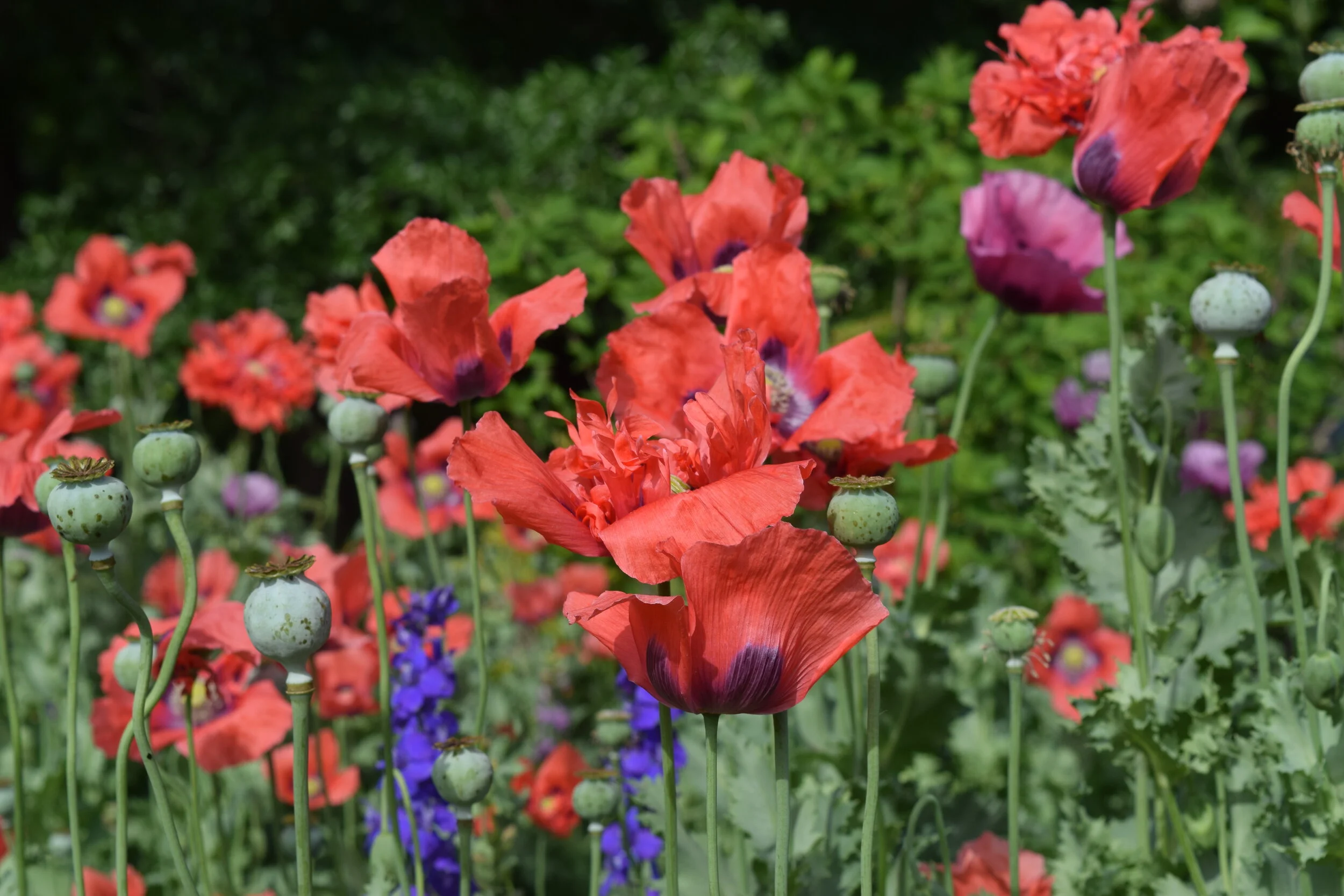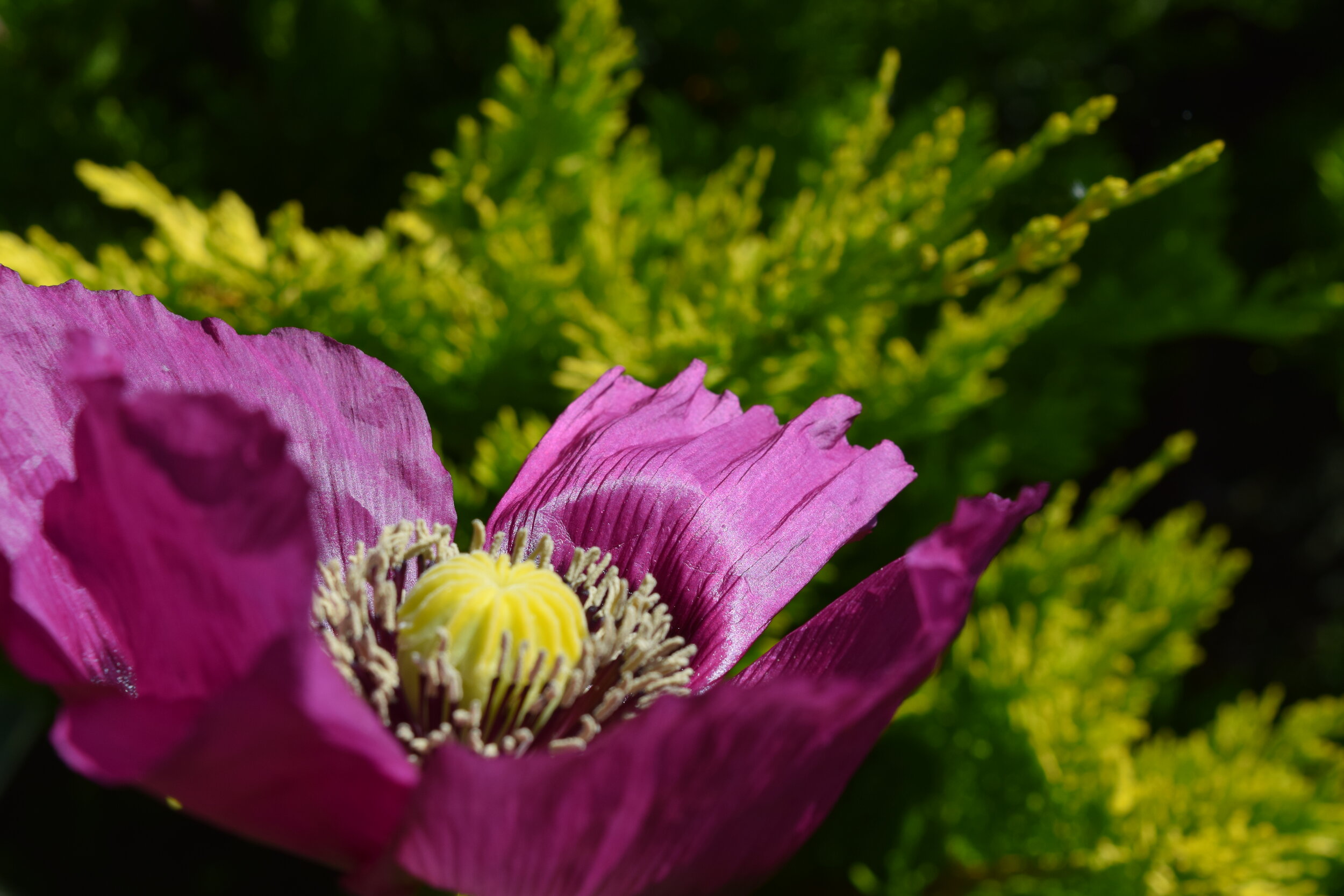I have been waiting, rather impatient, day after day for the poppies to open. The weather this spring has been MILD. Don’t get me wrong, I am not complaining about an entire month of no pollen and temps in the 50’s and 70’s, but to be honest it feels WEIRD! This is not our normal North Carolina spring. And therefore, the April blooms are way behind “normal.”
I am trying to train myself to stop using words like “normal” or “usually” because, if I have learned anything in the past 50 days of being home, NOTHING IS OR WILL EVER BE NORMAL AGAIN. It is a hard habit to break, though, especially when you garden. You see, time for me, is based of the rhythms of the plants that I cultivate. When “benchmarks” are met, like blooming, it provides me the sense of time and season. When we have an “unusually” mild month, like April 2020, everything is off kilter for me… and my plants!
But, FINALLY, the poppies, Pappaver somniferum, that I direct sowed last Thanksgiving are starting to bloom. With that first colorful pod opening life started to feel a bit more “normal”, like seeing an old friend -live-and-in person not via Zoom!
The rainbow of colors are a marvel to see- it is genetics at work. No cultivars, just open pollinated seed scattered on the bare earth in late fall. From that simple act of “sprinkling pixie dust” that provides this epic scene erupts each year.
HOW DO YOU GROW POPPIES?
Poppies are remarkably easy to grow, which is probably the issue that most people have. They don’t require a lot of time or attention, however they do require LIGHT TO GERMINATE. It is my theory that is what most gardeners do wrong, and why most people do not have success growing this magnificent plant. They just cant sow the seed and walk away…. but that is exactly what you have to do.
Successful poppy germination and growth require:
1) Direct sow- they do not transplant
2) They prefer COOL soil- sow in late November & December
3) NEED LIGHT TO GERMINATE- resist the urge to cover them with any soil or mulch
GARDENING WITH GRAINS
CHAPTER 8
I love all poppies, but I have a special devotion to the old-fashioned “bird seed” varieties that I was introduced to as an intern at Montrose gardens. They provide one of the most dynamic displays of mid spring and I simply cannot imagine my garden without them. The soft-green lettuce-like foliage stands out while the tall flower stalks can reach up to 4’ tall. Every stage of the poppy flower is noteworthy, from emergence to drying. Poppies offer architectural value and color while being an easy and inexpensive plant to fill in open areas of mulch space.
There are many different variants of poppies. The typical form has a single row of petals with a rainbow of colors to choose from, ranging from bright red, salmon, dark purple, lavender, pink and white. There are many fancy double forms with pom-pom-like petals. These are available from various seed suppliers, including Baker Creek Heirloom Seeds. If you are seeking a specific color or flower type, I recommend buying the seed each year from a reputable supplier. That way, you can be sure that you will get the exact color you want. When you collect your own, open-pollinated seed you will never know what the next generation will look like.
Fancied by a wide variety of pollinators, especially honeybees, the poppy flowers have a short duration of bloom. But the vibrant colors are unmatched by any other plant. And after the petals fall you can watch the seed head swell and ultimately dry. When the small “windows” open on the dried seed head, that is the sign that the seed is ripe and can, if you desire, be collected for the following year.
Just like larkspur, poppies do not transplant. Directly sowing the seed in the cool season is necessary. Poppies also require light to germinate, meaning they have to be on the surface of the soil. My best advice for growing poppies is to sow them last, after the grains and other flowering annuals, so you don’t step on them and push them into the soil. Do not cover them with soil or mulch, as that will impede their germination. Once established, they can self-sow, but that usually happens along bed edges, in gravel pathways and in the cracks of your driveway – never where you want them to grow! I always collect seed and re-sow at Thanksgiving to ensure I have the display I desire for the following spring. In cooler climates you can wait until March or April. I have heard of people tossing the seed into beds covered with snow, which resulted in late spring germination and a beautiful display in summer.
HOW DO YOU SOW POPPY SEED?
Watch this YouTube video to learn how
WHERE DO YOU GET YOUR SEED?
I harvest my own EVERY SPRING! I learned this technique 20 years ago while interning at Montrose Gardens in Hillsborough, NC. This is the only way you will be guaranteed to have seed for the next season. I harvest a lot- in “formal measuring terms” 5-10 Talienti Ice Cream containers worth. learn how I do it from in this YouTube video.
WHERE CAN YOU BUY SEED?
There are a lot of great online suppliers to purchase poppy seed from. Remember, this type is often sold as “breadseed poppy” but just confirm the botanical name of Pappaver somniferum to ensure you are buying this species of poppy.
Baker Creek Heirloom Seed has a wide assortment available
My go-to seed source has been Baker Creek for more than a decade. Their seed always germinates and the website is easy to navigate and filled with beautiful images. I really consider Baker Creek to be at the top of modern day seed production/ distribution. Their annual catalog is an encyclopedia of veggies, flowers and so much more. I use that as a reference more than any other gardening book.
May 2018 Poppy and Larkspur display
WHEN SHOULD YOU SOW POPPY SEED?
I have referred to this several times already, but for redundancy sake, sow poppies when the soil is cool. Here in central North Carolina zone 7 that means late fall. Ideally, sow your poppy seed (and a bunch of other cool season flowers and edibles) on black Friday! Avoid the crowds and spend some quality time outside instead. Besides, this year, everything will be purchased on-line so you really have no where else to be.
DO POPPIES RE-SEED?
YES! especially if you are like me and don’t apply too much mulch over the season. Remember, poppies need LIGHT to germinate, which means they will not germinate under mulch. This is why you often see poppies growing right along bed edges and in gravel pathways.
As a poppy growing fanatic, I have adjusted my expectation of “neat and tidy” through spring so I can fully enjoy the wild nature of plants like poppies, larkspur and bachelor buttons. I let them self sow and add additional seed to primary areas in late fall. Often the first blooms are from those self sown in the middle of a pathway. If that drives you crazy, pull it out. For me, I can step around it for a few weeks and enjoy this natural display with awe and wonder. Plants are amazing resilient. We humans can a learn a lot from them.



















